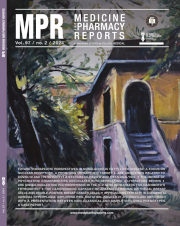Are single nucleotide polymorphisms in the IL-2 gene biomarkers for Hashimoto’s thyroiditis?
DOI:
https://doi.org/10.15386/mpr-2739Keywords:
IL-2 gene, Hashimoto’s thyroiditis, antibodies, Sanger sequencing method, thyroid autoimmune pathologyAbstract
Background and aims. Hashimoto’s thyroiditis (HT) is an autoimmune disorder that can lead to hypothyroidism. The pathophysiology of HT involves the production of antithyroid antibodies that attack the thyroid tissue, causing inflammation and progressive fibrosis. Recent studies demonstrated a strong correlation between Interleukin-2 (IL-2) levels and the development of autoimmune diseases, suggesting that this cytokine may play a crucial role in the pathogenesis of HT.
Methods. In this study, we determined the presence of the point mutation +114T/G in the IL-2 gene in patients with HT compared with a control group, and also the serum level of anti-thyroid peroxidase (TPOAbs) and anti-thyroglobulin (TgAbs) antibodies in HT patients with vs. without the mutation. The sequences of the IL-2 gene obtained from subjects were determined by the Sanger sequencing method.
Results. Our study did not reveal that the +114T/G polymorphism of the IL-2 gene is a susceptibility or protective factor for HT. No significant correlations were observed between the reference genotype, hetero- and homozygous +114T/G polymorphism and TPOAbs, respectively TgAbs serum levels in HT patients.
Conclusions. Further studies of more cases are needed to identify more polymorphisms in the IL-2 gene and study their correlations with HT.
Downloads
Published
How to Cite
Issue
Section
License
The authors are required to transfer the copyright of the published paper to the journal. This is done by agreeing to sign the Copyright Assignment Form. Whenever the case, authors are also required to send permissions to reproduce material (such as illustrations) from the copyright holder.

The papers published in the journal are licensed under a Creative Commons Attribution-NonCommercial-NoDerivatives 4.0 International License.

